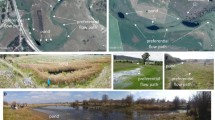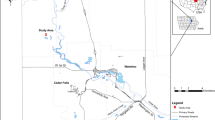Abstract
Growing populations and food demand in the tropics are leading to increased environmental pressures on wetland ecosystems, including a greater reliance on natural wetlands for water quality improvement. Effective assessment of wetland treatment potential requires an improved understanding of the hydraulic and biogeochemical factors that govern contaminant behavior, however detailed studies of flow through natural, tropical wetlands are scarce. We performed a tracer study using a conservative salt (potassium bromide) to examine the hydraulic behavior of a small, natural wetland in the Costa Rican humid tropics and modeled observed breakthrough curves using the 1-D advection–dispersion equation. Velocities in the wetland were extremely slow, from less than 4 m day−1 to a maximum of ~30 m day−1, and were distributed across several flowpaths, illustrating a spatial heterogeneity of flow and velocities. Modeled dispersion coefficients were also low (33 ± 33 m2 day−1). Estimated residence times suggested high potential pollutant removal capacity over a range of influent concentrations, reinforcing the environmental services provided by this and other small tropical wetlands. The study also highlighted how small variations in wetland topography and vegetation yield strong differences in transport patterns that affect transport and mixing in densely vegetated, heterogeneous wetland systems. Empirical data on the hydraulics, and resulting ecosystem functions, of small, distributed wetlands may provide support for improved conservation and management of these important ecosystems.







Similar content being viewed by others
Abbreviations
- Br− :
-
Bromide
- BTC:
-
Breakthrough curve
- τ:
-
Residence time
References
Bachand PAM, Horne AJ (2000) Denitrification in constructed free-water surface wetlands: II. Effects of vegetation and temperature. Ecol. Eng. 14(1–2):17–32
Bear J (1988) Dynamics of fluids in porous media. Dover, Mineola
Brouwer R, Langford IH, Bateman IJ, Turner RK (1999) A meta-analysis of wetland contingent valuation studies. Reg. Environ. Change 1(1):47–57. doi:10.1007/S101130050007
Bullock A (1993) 13: Perspectives on the hydrology and water resource management of natural freshwater wetlands and lakes in the humid tropics. Hydrology and water management in the humid tropics: hydrological research issues and strategies for water management 273
Chambers P, Prepas E, Hamilton H, Bothwell M (1991) Current velocity and its effect on aquatic macrophytes in flowing waters. Ecol. Appl. 1:249–257
Choi J, Harvey JW (2000) Quantifying time-varying ground-water discharge and recharge in wetlands of the northern Florida Everglades. Wetlands 20(3):500–511
Choi J, Harvey JW (2014) Relative significance of microtopography and vegetation as controls on surface water flow on a low-gradient floodplain. Wetlands 34(1):101–115
Daniels AE, Cumming GS (2008) Conversion or conservation? Understanding wetland change in northwest Costa Rica. Ecol. Appl. 18(1):49–63. doi:10.1890/06-1658.1
Debusk TA, Laughlin RB, Schwartz LN (1996) Retention and compartmentalization of lead and cadmium in wetland microcosms. Water Res. 30(11):2707–2716. doi:10.1016/S0043-1354(96)00184-4
Doble M, Kumar A (2005) Biotreatment of industrial effluents. Butterworth-Heinemann, Burlington
Ellison AM (2004) Wetlands of Central America. Wetlands Ecol. Manage. 12(1):3–55
Ewel KC (1990) Multiple demands on wetlands. Bioscience 40:660–666
Feld CK, Martins da Silva P, Paulo Sousa J, De Bello F, Bugter R, Grandin U, Harrison P (2009) Indicators of biodiversity and ecosystem services: a synthesis across ecosystems and spatial scales. Oikos 118(12):1862–1871
Gallardo M, César J (2006) Evaluación de la calidad natural del agua y su variación espacio temporal en el humedal la reserva, de la Universidad EARTH, zona caribe de Costa Rica. EARTH University, Lic Ing Agr, Guácimo
Gallardo B, Garcia M, Cabezas Á, Gonzalez E, Gonzalez M, Ciancarelli C et al (2008) Macroinvertebrate patterns along environmental gradients and hydrological connectivity within a regulated river-floodplain. Aquat. Sci. 70(3):248–258
Gibbs JP (2001) Wetland loss and biodiversity conservation. Conserv. Biol. 14(1):314–317
Gleason RA, Euliss NH Jr (1998) Sedimentation of prairie wetlands. Great Plains Res 363
Grismer ME, Tausendschoen M, Shepherd HL (2001) Hydraulic characteristics of a subsurface flow constructed wetland for winery effluent treatment. Water Environ. Res. 73(4):466–477
Grundl T, Small G (1993) Mineral contributions to atrazine and alachlor sorption in soil mixtures of variable organic carbon and clay content. J. Contam. Hydrol. 14(2):117–128
Hansson LA, Brönmark C, Anders Nilsson P, Åbjörnsson K (2005) Conflicting demands on wetland ecosystem services: nutrient retention, biodiversity or both? Freshw. Biol. 50(4):705–714
Harden HS, Chanton JP, Rose JB, John DE, Hooks ME (2003) Comparison of sulfur hexafluoride, fluorescein and rhodamine dyes and the bacteriophage PRD-1 in tracing subsurface flow. J. Hydrol. 277(1–2):100–115. doi:10.1016/S0022-1694(03)00074-X
Harvey JW, Saiers JE, Newlin JT (2005) Solute transport and storage mechanisms in wetlands of the Everglades, south Florida. Water Resour. Res. 41(5):W05009. doi:10.1029/2004wr003507
Hey DL, Philippi NS (2006) Flood reduction through wetland restoration: the Upper Mississippi River Basin as a case history. Restor. Ecol. 3(1):4–17
Ho DT, Engel VC, Variano EA, Schmieder PJ, Condon ME (2009) Tracer studies of sheet flow in the Florida Everglades. Geophys. Res. Lett. 36(9):L09401
Johnston CA (1991) Sediment and nutrient retention by freshwater wetlands: effects on surface water quality. Crit. Rev. Environ. Sci. Technol. 21(5–6):491–565
Junk WJ (2002) Long-term environmental trends and the future of tropical wetlands. Environ. Conserv. 29(4):414–435
Junk WJ, Bayley PB, Sparks RE (1989) The flood pulse concept in river-floodplain systems. Can Spec Publ Fish Aquat Sci 106(1):110–127
Kadlec RH (1994) Detention and mixing in free water wetlands. Ecol. Eng. 3(4):345–380
Kadlec RH, Wallace S (2008) Treatment wetlands. CRC press
Kaplan D, Bachelin M, Muñoz-Carpena R, Rodríguez Chacón W (2011) Hydrological importance and water quality treatment potential of a small freshwater wetland in the humid tropics of Costa Rica. Wetlands 31(6):1117–1130
Kaplan DA, Paudel R, Cohen MJ, Jawitz JW (2012) Orientation matters: patch anisotropy controls discharge competence and hydroperiod in a patterned peatland. Geophys Res Lett 39(17)
Keddy PA (2010) Wetland ecology: principles and conservation. Cambridge University Press, Cambridge
Keefe SH, Barber LB, Runkel RL, Ryan JN, McKnight DM, Wass RD (2004) Conservative and reactive solute transport in constructed wetlands. Water Resour. Res. 40(1):W01201
King AC, Mitchell CA, Howes T (1997) Hydraulic tracer studies in a pilot scale subsurface flow constructed wetland. Water Sci. Technol. 35(5):189–196
Kolln F (2008) Metodología para analizar la Dinámica Espacio-Temporal del Flujo Hídrico en el Humedal Natural “La Reserva”, Zona Caribe de Costa Rica. Lic Ing Agr, EARTH University, Guácimo, Costa Rica
Leonard L, Croft A, Childers D, Mitchell-Bruker S, Solo-Gabriele H, Ross M (2006) Characteristics of surface-water flows in the ridge and slough landscape of Everglades National Park: implications for particulate transport. Hydrobiologia 569(1):5–22
Martinez CJ (2001) Hydraulic characterization and modeling of the Orlando Easterly constructed treatment wetland. University of Florida, Gainesville
Martinez CJ, Wise WR (2003) Hydraulic analysis of Orlando easterly wetland. J. Environ. Eng. 129(6):553–560
McLaughlin D, Kaplan D, Cohen MJ (2014) In review. A significant nexus: geographically isolated wetlands influence landscape hydrology. Water Resour Res MS# 203WR015002
Min JH, Wise WR (2009) Simulating short-circuiting flow in a constructed wetland: the implications of bathymetry and vegetation effects. Hydrol. Process. 23(6):830–841
Mitsch WJ, Gosselink JG (2007) Wetlands. Wiley, New York
Mitsch WJ, Tejada J, Nahlik A, Kohlmann B, Bernal B, Hernández CE (2008) Tropical wetlands for climate change research, water quality management and conservation education on a university campus in Costa Rica. Ecol. Eng. 34(4):276–288
Nahlik AM, Mitsch WJ (2006) Tropical treatment wetlands dominated by free-floating macrophytes for water quality improvement in Costa Rica. Ecol. Eng. 28(3):246–257
Pang L, Goltz M, Close M (2003) Application of the method of temporal moments to interpret solute transport with sorption and degradation. J. Contam. Hydrol. 60(1):123–134
Reilly JF, Horne AJ, Miller CD (1999) Nitrate removal from a drinking water supply with large free-surface constructed wetlands prior to groundwater recharge. Ecol. Eng. 14(1):33–47
Roggeri H (1995) Tropical freshwater wetlands: a guide to current knowledge and sustainable management. Kluwer Academic Publishers, Dordrecht
Runkel RL, McKnight DM, Andrews ED (1998) Analysis of transient storage subject to unsteady flow: diel flow variation in an Antarctic stream. J North Am Benthological Soc 17(2):143–154
Saiers JE, Harvey JW, Mylon SE (2003) Surface-water transport of suspended matter through wetland vegetation of the Florida everglades. Geophysical Research Letters 30(19):1987
Sánchez-Carrillo S, Angeler DG, Álvarez-Cobelas M, Sánchez-Andrés R (2011) Freshwater wetland eutrophication. In: Eutrophication: causes, consequences and control. Springer, Netherlands, pp 195–210
Schaffranek RW, Riscassi AL (2004) Flow velocity, water temperature, and conductivity at selected locations in Shark River Slough, Everglades National Park, Florida; July 1999–July 2003: US Geological Survey
Schulz R, Peall SK (2001) Effectiveness of a constructed wetland for retention of nonpoint-source pesticide pollution in the Lourens River catchment, South Africa. Environ Sci Technol 35(2):422–426
Šimůnek J, Van Genuchten MT, Šejna M, Toride N, Leij F (1999) The STANMOD computer software for evaluating solute transport in porous media using analytical solutions of convection–dispersion equation, versions 1.0 and 2.0. International Ground Water Modeling Center
Snodgrass JW, Jagoe CH, Bryan AL Jr, Brant HA, Burger J (2000) Effects of trophic status and wetland morphology, hydroperiod, and water chemistry on mercury concentrations in fish. Can J Fish Aquat Sci 57(1):171–180
Stern DA, Khanbilvardi R, Alair JC, Richardson W (2001) Description of flow through a natural wetland using dye tracer tests. Ecol Eng 18(2):173–184
Toride N, Leij F, Van Genuchten MT (1995) The CXTFIT code for estimating transport parameters from laboratory or filed tracer experiments. US Salinity Laboratory, Riverside
Variano EA, Ho DT, Engel VC, Schmieder PJ, Reid MC (2009) Flow and mixing dynamics in a patterned wetland: kilometer-scale tracer releases in the Everglades. Water Resour Res 45(8):W08422
Zedler JB (2003) Wetlands at your service: reducing impacts of agriculture at the watershed scale. Front Ecol Environ 1(2):65–72
Acknowledgments
The authors thank Dr. Wynn Philips and the University of Florida (UF) Gatorade Foundation for the generous funding to support this research. This work would not have been possible without the contributions of Paul Lane, Timothy Townsend, Hwidong Kim (UF) and Julio Tejada, Faelen Tais Kolln, Maria Floridalma Miguel Ros, Natalia Solano Valverde, Pedro Bidegaray, and Daniel Sherrard (EARTH University). M. Bachelin thanks Dr. Andrea Rinaldo (École Polytechnique Fédérale de Lausanne) for M.Sc. co-supervision.
Author information
Authors and Affiliations
Corresponding author
Rights and permissions
About this article
Cite this article
Kaplan, D., Bachelin, M., Yu, C. et al. A hydrologic tracer study in a small, natural wetland in the humid tropics of Costa Rica. Wetlands Ecol Manage 23, 167–182 (2015). https://doi.org/10.1007/s11273-014-9367-1
Received:
Accepted:
Published:
Issue Date:
DOI: https://doi.org/10.1007/s11273-014-9367-1




